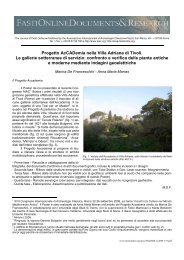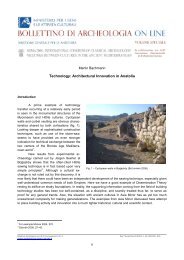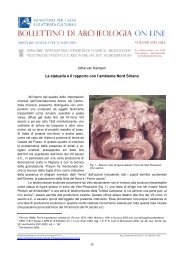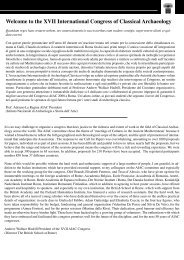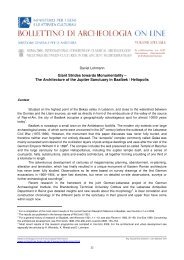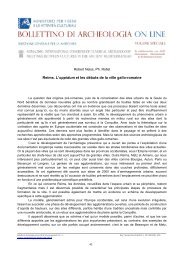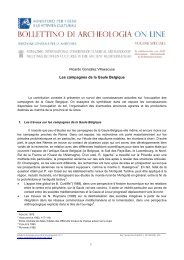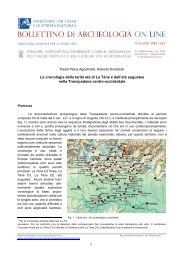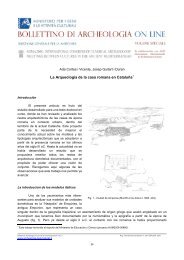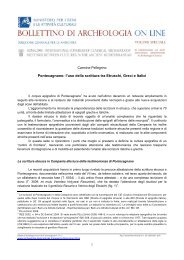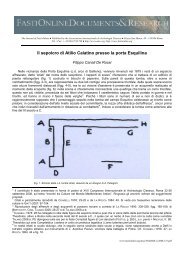Sarcophagi in Roman Britain - Bollettino di archeologia on line
Sarcophagi in Roman Britain - Bollettino di archeologia on line
Sarcophagi in Roman Britain - Bollettino di archeologia on line
You also want an ePaper? Increase the reach of your titles
YUMPU automatically turns print PDFs into web optimized ePapers that Google loves.
XVII Internati<strong>on</strong>al C<strong>on</strong>gress of Classical Archaeology, Roma 22-26 Sept. 2008Sessi<strong>on</strong>: <str<strong>on</strong>g>Roman</str<strong>on</strong>g> and BarbarianL<strong>on</strong>d<strong>on</strong> is over 145km from these quarries and that <str<strong>on</strong>g>in</str<strong>on</strong>g> the 14 th century it took seventeen days to br<str<strong>on</strong>g>in</str<strong>on</strong>g>g st<strong>on</strong>eby cart from Nott<str<strong>on</strong>g>in</str<strong>on</strong>g>gham to W<str<strong>on</strong>g>in</str<strong>on</strong>g>dsor, a <str<strong>on</strong>g>di</str<strong>on</strong>g>stance of around 200km, it is clear that significant amounts ofm<strong>on</strong>ey and effort were spent <strong>on</strong> procur<str<strong>on</strong>g>in</str<strong>on</strong>g>g sarcophagi <str<strong>on</strong>g>in</str<strong>on</strong>g> these areas, even if they rema<str<strong>on</strong>g>in</str<strong>on</strong>g>ed undecorated 42 .St<strong>on</strong>e as a material clearly had symbolic value.There is also good evidence from the cemeteries themselves to <str<strong>on</strong>g>in</str<strong>on</strong>g><str<strong>on</strong>g>di</str<strong>on</strong>g>cate the prestige value of evenundecorated sarcophagi. Al<strong>on</strong>gside the decorated and <str<strong>on</strong>g>in</str<strong>on</strong>g>scribed pieces from York, undecorated sarcophagihave also been recovered, many of them from the same cemetery sites, <str<strong>on</strong>g>in</str<strong>on</strong>g>clud<str<strong>on</strong>g>in</str<strong>on</strong>g>g the richly furnished <strong>on</strong>es<strong>on</strong> the Driffield Estate and at the Railway Stati<strong>on</strong> site, near the Scarborough Bridge 43 . In 1807 a barrelvaultedst<strong>on</strong>e-built mausoleum was <str<strong>on</strong>g>di</str<strong>on</strong>g>scovered <str<strong>on</strong>g>in</str<strong>on</strong>g> York that c<strong>on</strong>ta<str<strong>on</strong>g>in</str<strong>on</strong>g>ed an undecorated sarcophagus withassociated grave goods dat<str<strong>on</strong>g>in</str<strong>on</strong>g>g it to the late 3 rd century 44 . Similar mausolea, also c<strong>on</strong>ta<str<strong>on</strong>g>in</str<strong>on</strong>g><str<strong>on</strong>g>in</str<strong>on</strong>g>g undecoratedsarcophagi have been excavated <str<strong>on</strong>g>in</str<strong>on</strong>g> and around Cambridge 45 . S<str<strong>on</strong>g>in</str<strong>on</strong>g>ce funerary build<str<strong>on</strong>g>in</str<strong>on</strong>g>gs are generally rare <str<strong>on</strong>g>in</str<strong>on</strong>g><str<strong>on</strong>g>Roman</str<strong>on</strong>g> Brita<str<strong>on</strong>g>in</str<strong>on</strong>g>, these examples suggest a level of <str<strong>on</strong>g>in</str<strong>on</strong>g>vestment well above the norm.At Poundbury the ‘special burials’, <str<strong>on</strong>g>in</str<strong>on</strong>g> either st<strong>on</strong>e or lead coff<str<strong>on</strong>g>in</str<strong>on</strong>g>s were regularly arranged <str<strong>on</strong>g>in</str<strong>on</strong>g> clusters,the space between them filled with ord<str<strong>on</strong>g>in</str<strong>on</strong>g>ary graves, arranged <str<strong>on</strong>g>in</str<strong>on</strong>g> approximate rows. Few of these clustersc<strong>on</strong>ta<str<strong>on</strong>g>in</str<strong>on</strong>g>ed more than <strong>on</strong>e sarcophagus while groups of up to eight lead coff<str<strong>on</strong>g>in</str<strong>on</strong>g>s were comm<strong>on</strong>, perhaps<str<strong>on</strong>g>in</str<strong>on</strong>g><str<strong>on</strong>g>di</str<strong>on</strong>g>cative of the relative value of each material. In seven cases these ‘special burials’ were c<strong>on</strong>ta<str<strong>on</strong>g>in</str<strong>on</strong>g>ed with<str<strong>on</strong>g>in</str<strong>on</strong>g>built mausolea, <strong>on</strong>e of which was decorated with wall-pa<str<strong>on</strong>g>in</str<strong>on</strong>g>t<str<strong>on</strong>g>in</str<strong>on</strong>g>gs apparently depict<str<strong>on</strong>g>in</str<strong>on</strong>g>g a civic or religiousscene 46 . Numismatic and ceramic evidence from the site dates the earliest of coff<str<strong>on</strong>g>in</str<strong>on</strong>g>ed burials (Cemetery 3A)to the 3 rd century and many of the more elaborate <strong>on</strong>es to the 4 th (Cemetery 3C).Elsewhere, there is tantalis<str<strong>on</strong>g>in</str<strong>on</strong>g>g evidence for the <str<strong>on</strong>g>in</str<strong>on</strong>g>tegrati<strong>on</strong> of sarcophagus usage <str<strong>on</strong>g>in</str<strong>on</strong>g>to tra<str<strong>on</strong>g>di</str<strong>on</strong>g>ti<strong>on</strong>almodes of localized elite burial customs. In the limited time available a s<str<strong>on</strong>g>in</str<strong>on</strong>g>gle example, the barrow at Lord’sBridge, near Bart<strong>on</strong> <str<strong>on</strong>g>in</str<strong>on</strong>g> Cambridgeshire, will have to suffice 47 . This undecorated taper<str<strong>on</strong>g>in</str<strong>on</strong>g>g sarcophagus wasexcavated <str<strong>on</strong>g>in</str<strong>on</strong>g> 1907 from beneath the centre of a large barrow <strong>on</strong> the edge of the <str<strong>on</strong>g>Roman</str<strong>on</strong>g> road south-west ofCambridge. Accord<str<strong>on</strong>g>in</str<strong>on</strong>g>g to reports made at the time of excavati<strong>on</strong>, this barrow measured 14.6m by 7.3m andhad a maximum height of 2.6m, and was clearly <str<strong>on</strong>g>in</str<strong>on</strong>g>tended to be a visible m<strong>on</strong>ument <str<strong>on</strong>g>in</str<strong>on</strong>g> the landscape. Largebarrows of this k<str<strong>on</strong>g>in</str<strong>on</strong>g>d represent a c<strong>on</strong>t<str<strong>on</strong>g>in</str<strong>on</strong>g>uati<strong>on</strong> of late pre-<str<strong>on</strong>g>Roman</str<strong>on</strong>g> Ir<strong>on</strong> Age practices and, as Struck has noted,‘show signs of wealth such as <str<strong>on</strong>g>in</str<strong>on</strong>g>ternal grave c<strong>on</strong>structi<strong>on</strong>s, valuable c<strong>on</strong>ta<str<strong>on</strong>g>in</str<strong>on</strong>g>ers and costly grave goods, andquite frequently c<strong>on</strong>ta<str<strong>on</strong>g>in</str<strong>on</strong>g> status symbols’ 48 .What these examples clearly dem<strong>on</strong>strate is the prestige value of st<strong>on</strong>e coff<str<strong>on</strong>g>in</str<strong>on</strong>g>s <str<strong>on</strong>g>in</str<strong>on</strong>g> late <str<strong>on</strong>g>Roman</str<strong>on</strong>g> Brita<str<strong>on</strong>g>in</str<strong>on</strong>g>.The st<strong>on</strong>e from which these objects were carved was often transported l<strong>on</strong>g <str<strong>on</strong>g>di</str<strong>on</strong>g>stances at significantexpense. <str<strong>on</strong>g>Sarcophagi</str<strong>on</strong>g> are frequently associated with built mausolea, and occasi<strong>on</strong>ally barrows, tra<str<strong>on</strong>g>di</str<strong>on</strong>g>ti<strong>on</strong>allyhigh status modes of funerary <str<strong>on</strong>g>di</str<strong>on</strong>g>splay. At York, where the epigraphic evidence allows us an <str<strong>on</strong>g>in</str<strong>on</strong>g>sight <str<strong>on</strong>g>in</str<strong>on</strong>g>to thecharacter of the <str<strong>on</strong>g>in</str<strong>on</strong>g><str<strong>on</strong>g>di</str<strong>on</strong>g>viduals commemorated, sarcophagi were the preserve of the social elite – the municipaland military officials who dom<str<strong>on</strong>g>in</str<strong>on</strong>g>ated the upper echel<strong>on</strong>s of third- and fourth-century <str<strong>on</strong>g>Roman</str<strong>on</strong>g>o-British society.All of this is true even of the undecorated pieces tra<str<strong>on</strong>g>di</str<strong>on</strong>g>ti<strong>on</strong>ally neglected by scholarship. St<strong>on</strong>e, as a material,achieved status <str<strong>on</strong>g>in</str<strong>on</strong>g> Brita<str<strong>on</strong>g>in</str<strong>on</strong>g> dur<str<strong>on</strong>g>in</str<strong>on</strong>g>g this period <strong>on</strong>ly under external <str<strong>on</strong>g>in</str<strong>on</strong>g>fluences and these locally producedsarcophagi represent the ambiti<strong>on</strong>s of a local elite <str<strong>on</strong>g>in</str<strong>on</strong>g>fluenced by such external pressures.42 See SALZMAN 1967, 349, <strong>on</strong> transport times <str<strong>on</strong>g>in</str<strong>on</strong>g> Me<str<strong>on</strong>g>di</str<strong>on</strong>g>aeval England.43 See RAMM 1958, 413, WENHAM 1960, 316–317, and 1968, fig. 2.44 BANKS 1812.45 TAYLOR 2001, 114 (fig. 48).46 See GREEN 1982, 71–72.47 WALKER 1908.48 STRUCK 2000, 88.Bollett<str<strong>on</strong>g>in</str<strong>on</strong>g>o <str<strong>on</strong>g>di</str<strong>on</strong>g> Archeologia <strong>on</strong> l<str<strong>on</strong>g>in</str<strong>on</strong>g>e I 2010/ Volume speciale E / E10 / 2 Reg. Tribunale Roma 05.08.2010 n. 330 ISSN 2039 - 0076www.<str<strong>on</strong>g>archeologia</str<strong>on</strong>g>.beniculturali.it/pages/pubblicazi<strong>on</strong>i.html21



